Below are some examples of images produced by a photographer call Abelardo Morell (photos taken from his website http://www.abelardomorell.net/).
He produces these images in a mix of old fashion camera obscura technique and digital photography, what he does is first is turn a room completely dark by covering all the windows except for a small whole which the light from outside travels through and projects the image onto the opposite wall (it originally appears upside down but by using a prism he corrects this) then he captures the effect using a modern camera. Basically its alot like the way our own eyes capture images, what makes his work so interesting is the combination of the rooms and views that he finds and combines. Lets take the final example where the outside garden has be projected onto the wall, here its like you have to look twice to decide which parts are in the room and which are in the garden because the house plants blend so well into the theme. I also like the way the texture of the walls adds another dimension to an already clever concept.
What I'm thinking of doing for this assignment is something along the same idea but using photoshop to place landscapes onto the walls of room, i want it to feel like I've brought the outside into the room but i still want it to feel natural so maybe there should be some association between the two scenes. I'll have to think more on this but i thinks there's a good starting idea here.













































